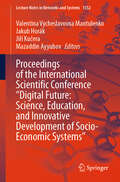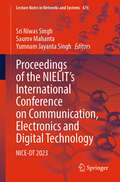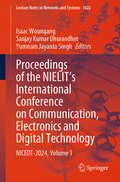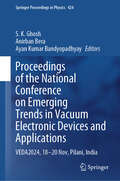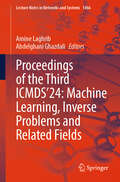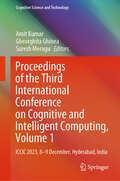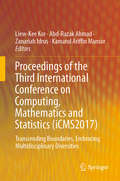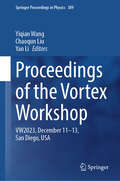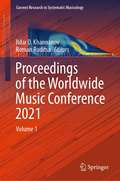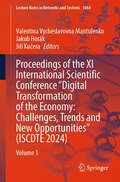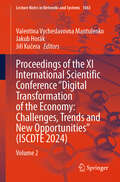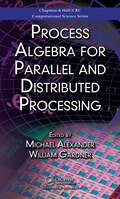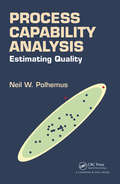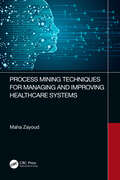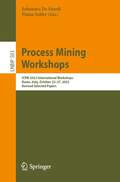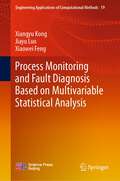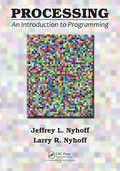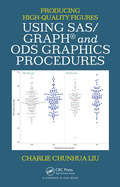- Table View
- List View
Proceedings of the International Scientific Conference "Digital Future: Science, Education, and Innovative Development of Socio-Economic Systems" (Lecture Notes in Networks and Systems #1552)
by Jakub Horák Valentina Vycheslavovna Mantulenko Jiří Kučera Mazaddin AyyubovThis book contains articles based on reports presented at the International Scientific Conference "Digital Future: Science, Education and Innovative Development of Socio-Economic Systems" held in Samara (Russia) in 2025. The volume covers innovative research in the field of digitalization of such areas as economics, science and education, modern problems and emerging new opportunities. The book presents expert views on new methodologies for applying AI in science and education, the impact of digital technologies on economic growth, company management and our society as a whole. We hope that this publication will enrich your understanding of the digital future through reflection and new ideas.
Proceedings of the NIELIT's International Conference on Communication, Electronics and Digital Technology: NICE-DT 2023 (Lecture Notes in Networks and Systems #676)
by Sri Niwas Singh Saurov Mahanta Yumnam Jayanta SinghThe book presents selected papers from NIELIT's International Conference on Communication, Electronics and Digital Technology (NICE-DT 2023) held during February 10–11, 2023, in New Delhi, India. The book covers state-of-the-art research insights on artificial intelligence, machine learning, big data, data analytics, cyber security and forensic, network and mobile security, advance computing, cloud computing, quantum computing, VLSI and semiconductors, electronics system, Internet of Things, robotics and automations, blockchain and software technology, digital technologies for future, assistive technology for divyangjan (people with disabilities) and Strategy for Digital Skilling for building a global Future Ready workforce.
Proceedings of the NIELIT's International Conference on Communication, Electronics and Digital Technology: NICEDT-2024, Volume 1 (Lecture Notes in Networks and Systems #1022)
by Isaac Woungang Sanjay Kumar Dhurandher Yumnam Jayanta SinghThe book presents selected papers from NIELIT's International Conference on Communication, Electronics and Digital Technology (NICEDT-2024) held during 16–17 February 2024 in Guwahati, India. The book is organized in two volumes and covers state-of-the-art research insights on artificial intelligence, machine learning, big data, data analytics, cybersecurity and forensic, network and mobile security, advance computing, cloud computing, quantum computing, VLSI and semiconductors, electronics system, Internet of Things, robotics and automations, blockchain and software technology, digital technologies for future, and assistive technology for Divyangjan (people with disabilities).
Proceedings of the NIELIT's International Conference on Communication, Electronics and Digital Technology: NICEDT-2024, Volume 2 (Lecture Notes in Networks and Systems #1023)
by Palaiahnakote Shivakumara Saurov Mahanta Yumnam Jayanta SinghThe book presents selected papers from NIELIT's International Conference on Communication, Electronics and Digital Technology (NICEDT-2024) held during 16–17 February 2024 in Guwahati, India. The book is organized in two volumes and covers state-of-the-art research insights on artificial intelligence, machine learning, big data, data analytics, cybersecurity and forensic, network and mobile security, advance computing, cloud computing, quantum computing, VLSI and semiconductors, electronics system, Internet of Things, robotics and automations, blockchain and software technology, digital technologies for future, and assistive technology for Divyangjan (people with disabilities).
Proceedings of the National Conference on Emerging Trends in Vacuum Electronic Devices and Applications: VEDA2024, 18-20 Nov, Pilani, India (Springer Proceedings in Physics #424)
by S. K. Ghosh Anirban Bera Ayan Kumar BandyopadhyayThis book presents peer reviewed articles from the Conference on Vacuum Electronic Devices Applications (VEDA2024) held at Pilani in India. Like its previous editions, it focusses on new ideas and the latest developments in research and industry on topics like technologies for vacuum electron devices (VEDs) or Systems and Subsystems employing VEDs, RF, HPM, and THz Components, Devices & Systems, RF, MW & mm-wave, Antennas and EM Simulations, Materials, power systems and components for VEDs, High emission density cathodes for VEDs, Applications of VEDs, Future trends & competing technologies. It brings together scientists, industrialists, academicians, and research scholars to exchange ideas and present latest developments in the field.
Proceedings of the Pacific Rim Statistical Conference for Production Engineering: Big Data, Production Engineering And Statistics (ICSA Book Series in Statistics)
by Tze Leung Lai Jun Ni Ying Lu Youngjo Lee Dongseok Choi Daeheung Jang Peter Qian Peihua Qiu George TiaoThis book presents the proceedings of the 2nd Pacific Rim Statistical Conference for Production Engineering: Production Engineering, Big Data and Statistics, which took place at Seoul National University in Seoul, Korea in December, 2016. The papers included discuss a wide range of statistical challenges, methods and applications for big data in production engineering, and introduce recent advances in relevant statistical methods.
Proceedings of the Third ICMDS'24: Machine Learning, Inverse Problems and Related Fields (Lecture Notes in Networks and Systems #1466)
by Amine Laghrib Abdelghani GhazdaliThis book offers innovative insights into the integration of machine learning and inverse problems, showcasing cutting-edge methodologies that enhance computational efficiency and accuracy. By leveraging artificial intelligence, optimization techniques, and high-performance computing, it addresses complex challenges across various scientific and industrial domains. The contributions featured in this book encompass theoretical advancements and practical applications, highlighting diverse topics such as data-driven approaches, uncertainty quantification, and algorithmic innovations. This interdisciplinary collection is designed for researchers, practitioners, and students interested in the transformative potential of informatics and computational sciences. By presenting meticulously reviewed papers from the Third International Conference on Mathematical and Computational Sciences (ICMDS 2024), this issue serves as a valuable resource for fostering further research and development, inspiring new approaches to solving pressing problems through advanced computational methods.
Proceedings of the Third International Conference on Cognitive and Intelligent Computing, Volume 1: ICCIC 2023, 8-9 December, Hyderabad, India (Cognitive Science and Technology)
by Amit Kumar Suresh Merugu Gheorghita GhineaThis book presents original, peer-reviewed select articles from the International Conference on Cognitive and Intelligent Computing (ICCIC-2023), held on December 8–9, 2023, at Hyderabad, in India. The book focuses on the comprehensive nature of computational intelligence, cognitive computing, AI, ML, and DL in order to highlight its role in the modelling, identification, optimisation, prediction, forecasting, and control of future intelligent systems. It includes contributions from a methodological/application standpoint in understanding artificial intelligence and machine learning approaches and their capabilities in solving a wide range of problems in the real world.
Proceedings of the Third International Conference on Cognitive and Intelligent Computing, Volume 2: ICCIC 2023, 8-9 December, Hyderabad, India (Cognitive Science and Technology)
by Amit Kumar Suresh Merugu Gheorghita GhineaThis book presents original, peer-reviewed select articles from the International Conference on Cognitive and Intelligent Computing (ICCIC-2023), held on December 8–9, 2023, at Hyderabad, in India. The book focuses on the comprehensive nature of computational intelligence, cognitive computing, AI, ML, and DL in order to highlight its role in the modelling, identification, optimisation, prediction, forecasting, and control of future intelligent systems. It includes contributions from a methodological/application standpoint in understanding artificial intelligence and machine learning approaches and their capabilities in solving a wide range of problems in the real world.
Proceedings of the Third International Conference on Computing, Mathematics and Statistics (iCMS2017): Transcending Boundaries, Embracing Multidisciplinary Diversities
by Abd-Razak Ahmad Zanariah Idrus Liew-Kee Kor Kamarul Ariffin MansorThis book is a product of the Third International Conference on Computing, Mathematics and Statistics (iCMS2017) to be held in Langkawi in November 2017. It is divided into four sections according to the thrust areas: Computer Science, Mathematics, Statistics, and Multidisciplinary Applications. All sections sought to confront current issues that society faces today. The book brings collectively quantitative, as well as qualitative, research methods that are also suitable for future research undertakings. Researchers in Computer Science, Mathematics and Statistics can use this book as a sourcebook to enrich their research works.
Proceedings of the Vortex Workshop: VW2023, December 11-13, San Diego, USA (Springer Proceedings in Physics #254)
by Yan Li Chaoqun Liu Yiqian WangWritten by the leading experts in the field, this book results from Vortex Workshop 2023 which took place in San Diego, the USA, on December 11–13. Vortex is ubiquitous in the universe such as tornado, hurricane, airplane tip vortex, and even star vortex in Galaxy. Vortices are also building blocks, muscles, and sinews of turbulent flows. A vortex is intuitively recognized as a rotational/swirling motion of fluids but until recently had no rigidly mathematical definition. In 1858, Helmholtz first defined vortex as composed of so-called vortex filaments, which are infinitesimal vorticity tubes, which is called as the first generation of vortex definition and identification, or G1. Although G1 has been accepted by the fluid dynamics community and almost all textbooks for over a century, we can find many immediate counterexamples, for example, in the laminar boundary layer, where the vorticity (shear) is very large near the wall, but not rotation (no vortex) exists. To solve these contradictions, many vortex criteria methods have been developed during the past 4 decades. More popular methods are represented by the Q, ∆, criteria methods. These methods have achieved part of success in vortex identification, which are called the second generation of vortex identification or G2. However, G2 has several critical drawbacks. First, they are all scalars which have no rotation axis directions, but vortex is a vector. It is hard or impossible to use a scalar to represent a vector. Second, like vorticity, these criteria methods are all contaminated by shear in different degrees. Third, they are all very sensitive on threshold selections. The recently developed Liutex is called the third generation of vortex definition and identification, or G3, which is a uniquely defined vector.
Proceedings of the Worldwide Music Conference 2021: Volume 1 (Current Research in Systematic Musicology #8)
by Ildar D. Khannanov Roman RuditsaThis book presents sixteen chapters in Volume 1. This Volume I of the Proceedings of the Worldwide Music Conference 2021 offers a smorgasbord of scientific approaches to music. The congress is one of a kind; it is dedicated not to a specific field but to the interdisciplinary developments and the interaction with the representatives from actual scientific disciplines. The languages of mathematics, computer science, semiotics, palaeography, and medicine are in the mix; geography of the studies is also impressive—Greece, Mexico, China, Russia, India, Poland, and USA, to name just a few. The purpose of such juxtaposition is to see how the terminology, categorical apparatus, and interpretations of music vary from science to science and how this can enrich the terminology of music theory. They cover a wide range of topics that the editors divided into four subfields: music in interdisciplinary contexts, music and current technology, musical instruments and voice, and music pedagogy and medicine. The opening section of the Proceedings is thus dedicated to the idea of interdisciplinarity, relationship of creator of theory of harmony Rameau to sciences of his time, the idea of number in music, co-creation, and the category of musical network. Three more chapters here deal with Russian palaeography, Indian musical genre, and the idea of musical semiotics. It is a kind of opening statement from music theorists. Part two, music and current technology, united three chapters, on “zero gravity” concept in modern music, discussion of scales as mathematical networks, and the innovation in digital music making, transforming it from stationary to mobile applications. The third part, musical instruments and voice, is of special interest because it is in the study of the instruments, the design, acoustic characteristics, and tuning, and sciences have cooperated with music theory for centuries. In addition to instruments, one chapter here is dedicated to voice. The last part, musical pedagogy and medicine, takes the reader even further into the interdisciplinary domain. The Proceedings is written in standard English language, prepared for the pleasure of reading of wide circles of professionals in different fields. The purpose of the editors is to bring this rather diverse set of texts into the context of a fruitful dialogue.
Proceedings of the XI International Scientific Conference "Digital Transformation of the Economy: Volume 1 (Lecture Notes in Networks and Systems #1064)
by Jakub Horák Valentina Vycheslavovna Mantulenko Jiří KučeraThis book includes selected reports of the XI International Scientific Conference “Digital Transformation of the Economy: Challenges, Trends and New Opportunities” (ISCDTE 2024), Samara, Russia. The proceedings volumes present the latest research on the digital transformation of the economy, its challenges, trends and new opportunities. The conference mainly focused on issues of the digital transformation, such as the theoretical background for the development of socio-economic systems in the digital age and specific practical issues related to actual business practices. Consisting of 8 chapters corresponding to the thematic areas of the conference, and written by scientists and practitioners from different regions, the book offers answers to the most pressing questions for contemporary business, research, engineering and education community from the perspective of the new reality.
Proceedings of the XI International Scientific Conference "Digital Transformation of the Economy: Volume 2 (Lecture Notes in Networks and Systems #1063)
by Jakub Horák Valentina Vycheslavovna Mantulenko Jiří KučeraThis book includes selected reports of the XI International Scientific Conference “Digital Transformation of the Economy: Challenges, Trends and New Opportunities” (ISCDTE 2024), Samara, Russia. The proceedings volumes present the latest research on the digital transformation of the economy, its challenges, trends and new opportunities. The conference mainly focused on issues of the digital transformation, such as the theoretical background for the development of socio-economic systems in the digital age and specific practical issues related to actual business practices. Consisting of 8 chapters corresponding to the thematic areas of the conference, and written by scientists and practitioners from different regions, the book offers answers to the most pressing questions for contemporary business, research, engineering and education community from the perspective of the new reality.
Process Algebra for Parallel and Distributed Processing
by William Gardner Michael AlexanderCollects the Latest Research Involving the Application of Process Algebra to ComputingExploring state-of-the-art applications, Process Algebra for Parallel and Distributed Processing shows how one formal method of reasoning-process algebra-has become a powerful tool for solving design and implementation challenges of concurrent systems. Parallel Pr
Process Capability Analysis: Estimating Quality
by Neil W. PolhemusProcess Capability Analysis: Estimating Quality presents a systematic exploration of process capability analysis and how it may be used to estimate quality. The book is designed for practitioners who are tasked with insuring a high level of quality for the products and services offered by their organizations. Along with describing the necessary statistical theory, the book illustrates the practical application of the techniques to data that do not always satisfy the standard assumptions. <P><P> The first two chapters deal with attribute data, where the estimation of quality is restricted to counts of nonconformities. Both classical and Bayesian methods are discussed. The rest of the book deals with variable data, including extensive discussions of both capability indices and statistical tolerance limits. Considerable emphasis is placed on methods for handling non-normal data. Also included are discussions of topics often omitted in discussions of process capability, including multivariate capability indices, multivariate tolerance limits, and capability control charts. A separate chapter deals with the problem of determining adequate sample sizes for estimating process capability. <P><P> Features: <li> Comprehensive treatment of the subject with consistent theme of estimating percent of nonconforming product or service. <li> Includes Bayesian methods. <li> Extension of univariate techniques to multivariate data. <li> Demonstration of all techniques using Statgraphics data analysis software. <P><P> Neil Polhemus is Chief Technology Officer at Statgraphics Technology and the original developer of the Statgraphics program for statistical analysis and data visualization. Dr. Polhemus spent 6 years on the faculty of the School of Engineering and Applied Science at Princeton University before moving full-time to software development and consulting. He has taught courses dealing with statistical process control, design of experiments and data analysis for more than 100 companies and government agencies.
Process Capability Indices: A Comprehensive Exposition Of Quality Control Measures (Series On Quality, Reliability And Engineering Statistics #Vol. 12)
by Samuel Kotz Norman L. JohnsonA solid, rigorous, yet comprehensible analysis of process capability indices, this work bridges the gap between theoretical statisticians and quality control practitioners, showing how an understanding of these indices can lead to process improvement.
Process Mining Techniques for Managing and Improving Healthcare Systems
by Maha ZayoudThis book discusses a new process mining method along with a detailed comparison between different techniques that provide a complete vision of the process of data acquisition, data analysis, and data prediction. Process Mining Techniques for Managing and Improving Healthcare Systems offers a new framework for process learning which is probabilistic and enables the process to be learned in an accumulative manner. The steps of prediction modeling and building the required knowledge are highlighted throughout the book, along with a strong emphasis on the correlation between the healthcare domain and technology including the different aspects, such as: managing records, information, and procedures; early detection of diseases; and the improvement of accuracy in choosing the right treatment procedures. This reference provides a wealth of knowledge for practitioners, researchers, and students at the basic and intermediary levels working within the healthcare system, computer science, electronics and communications, as well as medical providers and also hospital management entities.
Process Mining Workshops: ICPM 2023 International Workshops, Rome, Italy, October 23–27, 2023, Revised Selected Papers (Lecture Notes in Business Information Processing #503)
by Pnina Soffer Johannes De SmedtThis volume constitutes the revised selected papers of several workshops which were held in conjunction with the 5th International Conference on Process Mining, ICPM 2023, held in Rome, Italy, in October 23–27, 2023.The 38 revised full papers presented in this book were carefully reviewed and selected from 85 submissions. The book also contains one invited talk. ICPM 2023 presented the following six workshops:– 4th International Workshop on Event Data and Behavioral Analytics (EdbA)– 4th International Workshop on Leveraging Machine Learning in Process Mining (ML4PM)– 6th International Workshop on Process-Oriented Data Science for Healthcare (PODS4H)– 8th International Workshop on Process Querying, Manipulation, and Intelligence (PQMI)– 2nd International Workshop on Education Meets Process Mining (EduPM)– 2nd International Workshop on Collaboration Mining for Distributed Systems (COMINDS).
Process Mining Workshops: ICPM 2024 International Workshops, Lyngby, Denmark, October 14–18, 2024, Revised Selected Papers (Lecture Notes in Business Information Processing #533)
by Andrea Delgado Tijs SlaatsThis book constitutes the revised accepted papers of several workshops which were held in conjunction with the 6th International Conference on Process Mining, ICPM 2024, held in Lyngby, Denmark, during October 2024. The 56 revised full papers presented in this book were carefully reviewed and selected from 126 submissions. The papers presented in this volume stem from the following workshops: – 9th International Workshop on Process Querying, Manipulation, and Intelligence (PQMI) – 3rd International Workshop on Education Meets Process Mining (EduPM) – 3rd International Workshop on Collaboration Mining for Distributed Systems (CoMinDS) – 5th International Workshop on Leveraging Machine Learning in Process Mining (ML4PM) – 5th International Workshop on Event Data and Behavioral Analytics (EdbA) – 7th International Workshop on Process-Oriented Data Science for Healthcare (PODS4H) – 1st International Workshop on Empirical Research in Process Mining (ERPM) – 1st International Workshop on Generative Artificial Intelligence for Process Mining (GenAI4PM) – 4th International Workshop on Stream Management & Analytics for Process Mining (SMA4PM) – 1st International Workshop on Process Mining for Sustainability (PM4S).
Process Monitoring and Fault Diagnosis Based on Multivariable Statistical Analysis (Engineering Applications of Computational Methods #19)
by Xiangyu Kong Jiayu Luo Xiaowei FengThis book reports the developments of the Total Least Square (TLS) algorithms for parameter estimation and adaptive filtering. Specifically, this book introduces the authors’ latest achievements in the past 20 years, including the recursive TLS algorithms, the approximate inverse power iteration TLS algorithm, the neural based MCA algorithm, the neural based SVD algorithm, the neural based TLS algorithm, the TLS algorithms under non-Gaussian noises, performance analysis methods of TLS algorithms, etc. In order to faster the understanding and mastering of the new methods provided by this book for readers, before presenting each new method in each chapter, a specialized section is provided to review the closely related several basis models. Throughout the book, large of procedure of new methods are provided, and all new algorithms or methods proposed by us are tested and verified by numerical simulations or actual engineering applications. Readers will find illustrative demonstration examples on a range of industrial processes to study. Readers will find out the present deficiency and recent developments of the TLS parameter estimation fields, and learn from the the authors’ latest achievements or new methods around the practical industrial needs. In my opinion, this book can be assimilated by advanced undergraduates and graduate (PH.D.) students, as well as statisticians, because of the new tools in data analysis, applied mathematics experts, because of the novel theories and techniques that we propose, engineers, above all for the applications in control, system identification, computer vision, and signal processing.
Process Plant Operating Procedures: Synthesis, Simulation and Abnormal Situation Management (Advances in Industrial Control)
by Chuei-Tin Chang Hao-Yeh Lee Vincentius Surya AdiProcess Plant Operating Procedures presents an introduction to the theory and applications of procedure synthesis that is primarily concerned with the task of conjecturing the sequence of controller (or operator) actions needed to achieve designated operational goals in a given system. In order to facilitate practical implementation, the formal problem statement, two alternative approaches, their validation methods and a series of realistic examples are provided. The authors explore Petri nets and automata to identify the best paths leading to the specified goal of operation. The model-building methods for characterising all components in the given system, as well as the required control specifications, are explained with simple examples. The sequential control actions and the corresponding time schedule can then be identified accordingly. This book exposes practitioners to an important area of plant operations, teaching them effective approaches for procedure synthesis, enabling them to construct and solve scheduling models, and providing them with tools for simulation and validation of procedures and schedules. It is written for readers with a basic understanding of process design and control activities, and it will appeal to engineers in diverse fields with an interest in synthesizing operating procedures in process plants.Advances in Industrial Control reports and encourages the transfer of technology in control engineering. The rapid development of control technology has an impact on all areas of the control discipline. The series offers an opportunity for researchers to present an extended exposition of new work in all aspects of industrial control.
Processing Networks: Fluid Models and Stability
by J. Michael Harrison J. G. DaiThis state-of-the-art account unifies material developed in journal articles over the last 35 years, with two central thrusts: It describes a broad class of system models that the authors call 'stochastic processing networks' (SPNs), which include queueing networks and bandwidth sharing networks as prominent special cases; and in that context it explains and illustrates a method for stability analysis based on fluid models. The central mathematical result is a theorem that can be paraphrased as follows: If the fluid model derived from an SPN is stable, then the SPN itself is stable. Two topics discussed in detail are (a) the derivation of fluid models by means of fluid limit analysis, and (b) stability analysis for fluid models using Lyapunov functions. With regard to applications, there are chapters devoted to max-weight and back-pressure control, proportionally fair resource allocation, data center operations, and flow management in packet networks. Geared toward researchers and graduate students in engineering and applied mathematics, especially in electrical engineering and computer science, this compact text gives readers full command of the methods.
Processing: An Introduction to Programming
by Jeffrey L. Nyhoff Larry R. NyhoffThis book demonstrates how Processing is an excellent language for beginners to learn the fundamentals of computer programming. Originally designed to make it simpler for digital artists to learn to program, Processing is a wonderful first language for anyone to learn. Given its origins, Processing enables a multimodal approach to programming instruction, well suited to students with interests in computer science or in the arts and humanities. The book uses Processing’s capabilities for graphics and interactivity in order to create examples that are simple, illustrative, interesting, and fun. It is designed to appeal to a broad range of readers, including those who want to learn to program to create digital art, as well as those who seek to learn to program to process numerical information or data. It can be used by students and instructors in a first course on programming, as well as by anyone eager to teach them self to program. Following a traditional sequence of topics for introducing programming, the book introduces key computer science concepts, without overwhelming readers with extensive detail. Additional exercises are available, as are other supplementary materials for instructors looking to introduce even more computer science concepts associated with the topics. Several online chapters are also provided that introduce slightly more advanced topics in Processing, such as two-dimensional arrays, manipulation of strings, and file input and output. The conversational style and pace of the book are based upon the authors’ extensive experience with teaching programming to a wide variety of beginners in a classroom. No prior programming experience is expected.
Producing High-Quality Figures Using SAS/GRAPH and ODS Graphics Procedures
by Charlie Chunhua LiuThis book demonstrates how to create commonly used figures and plots with SAS/GRAPH and ODS Graphics procedures. It provides all the details on selecting the right figure formats, options, and fonts. In-depth instructions and SAS programs using procedures in both SAS/GRAPH and ODS Graphics show how to generate sample figures in listing graphics formats and ODS document files. Each chapter includes practical examples and SAS programs. Readers can easily modify the SAS programs to develop high-quality figures to meet their own needs.
